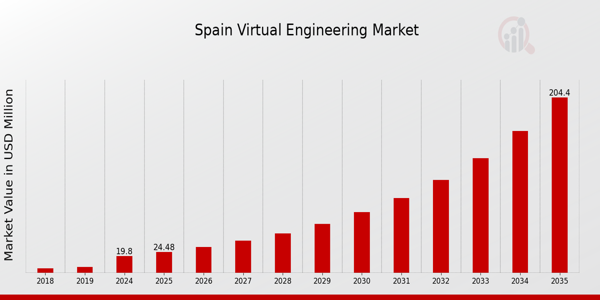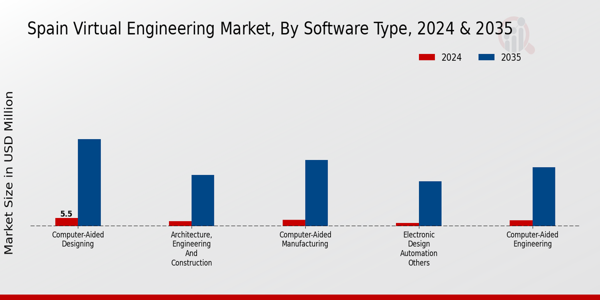Spain Virtual Engineering Market Overview
As per MRFR analysis, the Spain Virtual Engineering Market Size was estimated at 17.11 (USD Million) in 2023.The Spain Virtual Engineering Market Industry is expected to grow from 19.8(USD Million) in 2024 to 204.45 (USD Million) by 2035. The Spain Virtual Engineering Market CAGR (growth rate) is expected to be around 23.642% during the forecast period (2025 - 2035).
Key Spain Virtual Engineering Market Trends Highlighted
The Spain Virtual Engineering Market is undergoing significant trends that are influenced by a variety of factors. Key market drivers include the increasing adoption of digital technologies in sectors including aerospace, automotive, and construction. As a result of the Spanish companies' emphasis on efficiency and innovation, there has been a rise in the investment of virtual engineering solutions to optimize processes and minimize expenses.
This trend has been further bolstered by government policies that promote Industry 4.0 and digital transformation initiatives, which have encouraged businesses to implement advanced engineering tools in order to remain competitive. Particularly for small and medium-sized enterprises (SMEs), the field of virtual engineering presents substantial opportunities. Virtual engineering technologies can be employed by these Spanish companies to improve their product design and development capabilities, thereby accelerating the time to market.
Furthermore, the proliferation of remote work and collaboration tools has created a need for virtual simulation and testing platforms, which enables teams to operate efficiently from a variety of locations. Furthermore, educational institutions in Spain are integrating virtual engineering into their curricula to cultivate a workforce that is prepared to meet the demands of this rapidly changing market. It has been observed that the Spanish Virtual Engineering Market has been increasingly concerned with sustainability and eco-friendliness in recent years.
Businesses are looking for virtual solutions that can assist in the optimization of resource consumption and the development of more environmentally responsible products. Green engineering practices are increasingly being integrated into virtual simulation processes, which is consistent with Spain's dedication to sustainability. Generally, the future of virtual engineering in Spain is being established by the movement toward digital solutions, collaboration, and sustainability.

Spain Virtual Engineering Market Drivers
Rapid Technological Advancements
The Spain Virtual Engineering Market Industry is witnessing significant growth due to rapid advancements in technology, particularly in fields such as artificial intelligence and simulation software. The Spanish government has prioritized digital transformation within its sectors, aiming for a more robust digital economy to compete globally. According to the Ministry of Economic Affairs and Digital Transformation, they plan to invest approximately 100 million USD in fostering digital infrastructure by 2025.
This focus on innovation is further supported by established organizations like Siemens and Accenture, who have increased their presence in Spain, driving demand for advanced virtual engineering solutions that help companies enhance efficiency and reduce costs. As industries adopt these technologies, the virtual engineering market is expected to see robust growth, with significant contributions from sectors such as automotive and aerospace utilizing simulation tools to reduce R&D efforts by up to 30%.
Increased Demand for Customized Solutions
The trend towards personalized and customized engineering solutions is another primary driver for the Spain Virtual Engineering Market Industry. Businesses in Spain increasingly recognize the value of tailored solutions to meet unique operational needs. A recent report from the Spanish Confederation of Business Organizations indicates that approximately 45% of local companies prioritize bespoke solutions, emphasizing the importance of flexibility in engineering services.
Companies like Accenture and PTC have tailored their offerings to cater to this growing demand, ensuring they enhance productivity and efficiency through virtual engineering methods. This customization requirement aligns with the national strategy that promotes innovation as a core component of business competitiveness, thus propelling market growth.
Growing Investment in Research and Development
Growing investment in Research and Development (R&D) within various sectors is a key driver for the Spain Virtual Engineering Market Industry. The Spanish government has set ambitious R&D targets, aiming to increase overall expenditure to 2.12% of GDP by 2027, as outlined in the Spanish Strategy for Science, Technology and Innovation.
Major organizations such as Airbus and Indra are significantly investing in R&D, where virtual engineering plays a crucial role.These investments are fostering innovation and enhancing the capabilities of Spanish companies to compete on a global stage. With virtual engineering being an integral part of product development processes, this influx of capital is expected to accelerate market growth.
Spain Virtual Engineering Market Segment Insights
Virtual Engineering Market Software Type Insights
The Software Type segment of the Spain Virtual Engineering Market is witnessing significant evolution, driven by advancements in technology and increasing digitalization in various industries. The segment encompasses a variety of essential software categories, including Computer-Aided Designing (CAD), Computer-Aided Manufacturing (CAM), Computer-Aided Engineering (CAE), Architecture, Engineering and Construction (AEC), and Electronic Design Automation (EDA), among others. Computer-Aided Designing (CAD) holds a pivotal role in enhancing the precision and efficiency of design processes across sectors such as automotive, aerospace, and manufacturing. Its capabilities enable engineers and designers to create detailed 3D models, drastically improving product development timelines and overall quality.
On the other hand, Computer-Aided Manufacturing (CAM) is increasingly essential for optimizing production processes, improving manufacturing efficiency, and reducing wastage. By integrating CAM with CAD, companies can streamline the transition from design to manufacturing, leading to enhanced productivity and cost-effectiveness. In addition, Computer-Aided Engineering (CAE) plays a critical role in simulation and analysis, allowing organizations to test and validate designs in a virtual environment. This capability not only accelerates the product development cycle but also ensures compliance with safety and regulatory standards.
Furthermore, the Architecture, Engineering, and Construction (AEC) sector is leveraging Virtual Engineering solutions for project management, design coordination, and collaboration. These tools facilitate better communication among stakeholders and enhance project delivery timelines, making them indispensable for managing complex construction projects. Electronic Design Automation (EDA) is particularly significant in the electronics sector, providing solutions for designing, simulating, and testing electronic systems efficiently.
The growing integration of Artificial Intelligence and Machine Learning into these software types is transforming the landscape, offering predictive analytics and advanced automation capabilities that are reshaping industries. The Spain Virtual Engineering Market is also witnessing an increasing demand for cloud-based solutions, which enhance accessibility and collaboration among remote teams, thereby promoting innovative approaches for problem-solving.
With the Spanish government actively promoting digitization initiatives and smart manufacturing, investments in Virtual Engineering are likely to continue on an upward trajectory. The convergence of the software type segment with emerging technologies will present new opportunities, but organizations must also navigate challenges such as talent shortages and the need for continuous training to stay competitive in this rapidly evolving environment. In summary, the Software Type segment in the Spain Virtual Engineering Market highlights a strong drive towards efficiency, innovation, and performance improvement, paving the way for enhanced operational capabilities across multiple industries.

Virtual Engineering Market Deployment Type Insights
The Deployment Type segment of the Spain Virtual Engineering Market encompasses diverse deployment methods that optimize the delivery of virtual engineering solutions. This segment is primarily divided into On-premises and Cloud deployments, both of which hold unique significance in the market landscape. On-premises solutions are favored for their robust data security and control, catering particularly to industries like manufacturing and automotive, where data integrity is critical. Conversely, Cloud deployments are gaining traction due to their scalability and cost-effectiveness, facilitating real-time collaboration across geographically dispersed teams, which is essential in today’s dynamic work environment.
As the demand for digital transformation in Spain accelerates, the adoption of these deployment types is expected to grow, driven by advancements in technology and the evolving needs of businesses. This shift signifies opportunities for innovation in both sectors, with organizations increasingly recognizing the importance of selecting the right deployment type to support their operational strategies in the realm of virtual engineering. With Spain's commitment to enhancing its industrial capabilities, the Deployment Type segment is poised to play a crucial role in shaping the future of the Spain Virtual Engineering Market.
Virtual Engineering Market Organization Size Insights
The Spain Virtual Engineering Market is experiencing significant growth, reflecting broader trends in technological adoption across various sectors. When considering Organization Size, both small and medium-sized enterprises (SMEs) and large enterprises play crucial roles in market dynamics. SMEs, often viewed as innovative engines, are increasingly leveraging virtual engineering solutions to enhance operational efficiency and decrease costs, thereby driving the market forward. On the other hand, large enterprises contribute substantially through their extensive resources and established infrastructures, allowing them to implement advanced virtual engineering technologies more widely.
The growing emphasis on digital transformation in Spain's economy, supported by government initiatives and EU funding, further augments the adoption of virtual engineering solutions among both segments. SMEs are particularly important as they represent a diverse range of industries and bring agility to the market, while large enterprises provide stability and scalability. This segmentation is critical as it highlights varying needs and capabilities, with both types of organizations finding unique applications for virtual engineering to foster innovation, improve product development cycles, and enhance collaboration across teams.Overall, the collective impact of these organizations shapes the trajectory of the Spain Virtual Engineering Market, creating opportunities for vendors and stakeholders.
Virtual Engineering Market Application Insights
The Application segment of the Spain Virtual Engineering Market showcases a diverse range of functionalities that cater to the growing demands of various industries, including manufacturing, construction, and automotive. Automation Design plays a crucial role in enhancing efficiency and productivity, allowing companies to streamline operations and minimize human errors. Plant Design focuses on creating optimized layouts and designs that improve operational efficiency and safety within industrial environments.
Product Design is significant as it allows for rapid prototyping and innovation, helping businesses to bring products to market faster while ensuring high quality and consumer satisfaction.Furthermore, 3D Modelling is vital for visualization and simulation, enabling better decision-making through accurate representations of projects before physical execution. Each of these areas is driven by increasing technological advancements and a push for digital transformation within companies. Moreover, these functionalities not only boost competitiveness but also align with Spain's strategic initiatives toward enhancing innovation within the engineering and manufacturing sectors, contributing significantly to the overall Spain Virtual Engineering Market dynamics.
Virtual Engineering Market Industry Vertical Insights
The Spain Virtual Engineering Market, which is projected to see significant growth in the coming years, is categorized into various industry verticals, two of the prominent ones being the Commercial Industry Vertical and the Defense Industry Vertical. The Commercial Industry Vertical encompasses sectors such as manufacturing, automotive, and telecommunications, where virtual engineering plays a crucial role in enhancing design processes, reducing time-to-market, and improving cost efficiency. Meanwhile, the Defense Industry Vertical is vital for developing advanced simulation and modeling technologies that bolster military operations and training, ensuring optimal performance and safety.
The increased investment in Research and Development within these sectors, particularly in Spain, demonstrates a commitment to leverage digital transformation. Spain's government has also initiated policies to foster innovation in technology, thereby augmenting the Spain Virtual Engineering Market statistics. As companies seek to improve digital collaboration and streamline workflows, opportunities arise for software solutions that address specific needs in these verticals, making them significant contributors to the overall market growth. Challenges such as budget constraints and the need for skill development in advanced technologies pose potential barriers, yet the demand for virtual engineering solutions remains robust in both sectors.
Spain Virtual Engineering Market Key Players and Competitive Insights
The competitive landscape of the Spain Virtual Engineering Market is evolving rapidly, driven by advancements in technology and growing demand for innovative solutions across various sectors such as manufacturing, automotive, and information technology. Virtual engineering has become integral in enhancing product design, development, and testing processes, allowing companies to optimize their operations and reduce time to market.
As businesses increasingly embrace digital transformation, several key players are positioning themselves to capitalize on these trends by leveraging their expertise in simulation, modeling, and engineering software. The market is characterized by a mix of established firms and emerging startups that are driving competition through strategic partnerships, ongoing innovations, and tailored offerings designed to meet the specific needs of the Spanish market.
PTC has a solid presence in the Spain Virtual Engineering Market, known for its robust suite of engineering solutions, including its windchill and Creo product lines. Their strengths lie in their comprehensive offerings that facilitate product lifecycle management and advanced computer-aided design capabilities. PTC's commitment to integrating the Internet of Things with engineering processes, alongside its emphasis on providing strong customer support and training resources, positions it favorably within this competitive landscape. The company has effectively built partnerships with local organizations to enhance its service delivery and expand its market presence, ensuring that it remains at the forefront of virtual engineering innovation in Spain.
On the other hand, Oracle has increasingly established itself within the Spain Virtual Engineering Market by offering a range of cloud-based solutions that enhance the efficiency of virtual engineering processes. Oracle’s strengths include its advanced data analytics tools and design automation software, which are critical for companies looking to streamline engineering workflows and drive innovation. The company has actively engaged in strategic mergers and acquisitions to strengthen its capabilities in providing seamless integration of engineering solutions.
Oracle's presence in Spain is further bolstered by its comprehensive suite of enterprise resource planning tools that support organizations in managing their engineering data more effectively. By delivering scalable and agile solutions that cater to various industries, Oracle continues to solidify its position in the market, appealing to businesses seeking to optimize their virtual engineering efforts.
Key Companies in the Spain Virtual Engineering Market Include:
- PTC
- Oracle
- Ansys
- Siemens
- Bentley Systems
- Autodesk
- Accenture
- SAP
- Altair Engineering
- Dassault Systemes
- IBM
- Hexagon AB
Spain Virtual Engineering Market Industry Developments
Hexagon AB collaborated with Spanish authorities, including the Ministry for the Ecological Transition and TRAGSATEC, in May 2023 to create the first digital duplicate of the Campo de Cartagena region in Spain. Built on Hexagon's Luciad platform, the 3D web-based model facilitates the simulation and management of environmental factors such as water levels, vegetation, and pollution, thereby facilitating improved decision-making for disaster prevention and sustainability.
In January 2023, GlobalLogic, a subsidiary of Hitachi Group, disclosed its intention to establish new digital engineering centers throughout Spain, including Valencia, Málaga, Madrid, and Tarragona. These will provide digital engineering services, including software, design, and data engineering, to expedite clients' digital transformation in accordance with Spain's "Digital Spain 2026" framework. Siemens established a new technology center in Tres Cantos (Madrid) in June 2025, complete with a satellite team in Aragon.
As a foundation for the development of virtual engineering capabilities in southern Europe, this center concentrates on innovation in digital infrastructure, which includes AI, IoT, 5G, and cloud. Siemens and Telefónica announced a partnership in January 2025 to establish digitalized environments through the utilization of their Innovation & Talent Hub (Telefónica District) and Digital Experience Centers (Madrid, Barcelona). The objective of their collaborative professional services is to incorporate digital technologies into the automotive and industrial sectors.
Spain Virtual Engineering Market Segmentation Insights
Virtual Engineering Market Software Type Outlook
-
- Computer-Aided Designing (CAD)
- Computer-Aided Manufacturing (CAM)
- Computer-Aided Engineering (CAE)
- Architecture, Engineering and Construction (AEC)
- Electronic Design Automation (EDA)Others
Virtual Engineering Market Deployment Type Outlook
Virtual Engineering Market Organization Size Outlook
Virtual Engineering Market Application Outlook
-
- Automation Design
- Plant Design
- Product Design
- 3D MODELLING
- Others
Virtual Engineering Market Industry Vertical Outlook
-
- Commercial Industry Vertical
- Defense Industry Vertical
| Report Attribute/Metric Source: |
Details |
| MARKET SIZE 2023 |
17.11(USD Million) |
| MARKET SIZE 2024 |
19.8(USD Million) |
| MARKET SIZE 2035 |
204.45(USD Million) |
| COMPOUND ANNUAL GROWTH RATE (CAGR) |
23.642% (2025 - 2035) |
| REPORT COVERAGE |
Revenue Forecast, Competitive Landscape, Growth Factors, and Trends |
| BASE YEAR |
2024 |
| MARKET FORECAST PERIOD |
2025 - 2035 |
| HISTORICAL DATA |
2019 - 2024 |
| MARKET FORECAST UNITS |
USD Million |
| KEY COMPANIES PROFILED |
PTC, Oracle, Ansys, Siemens, Bentley Systems, Autodesk, Accenture, SAP, Altair Engineering, 3D Systems, Dassault Systemes, IBM, Hexagon AB, ENGIE, Fujitsu |
| SEGMENTS COVERED |
Software Type, Deployment Type, Organization Size, Application, Industry Vertical |
| KEY MARKET OPPORTUNITIES |
Increased demand for remote collaboration, Growing adoption in manufacturing sectors, Need for cost-effective design solutions, Expansion of AR/VR technologies, Rising focus on sustainable engineering practices |
| KEY MARKET DYNAMICS |
growing demand for remote collaboration, increasing investments in R&D, advancements in simulation technologies, rising adoption of cloud solutions, focus on cost reduction and efficiency |
| COUNTRIES COVERED |
Spain |
Frequently Asked Questions (FAQ):
The Spain Virtual Engineering Market is expected to be valued at 19.8 million USD in 2024.
The market is expected to have a compound annual growth rate (CAGR) of 23.642% during the period from 2025 to 2035.
By 2035, the Spain Virtual Engineering Market is projected to reach a value of 204.45 million USD.
Computer-Aided Designing (CAD) is expected to dominate the market, with a projected value of 57.79 million USD in 2035.
Major players include PTC, Oracle, Ansys, Siemens, Bentley Systems, Autodesk, and Accenture.
The market for Computer-Aided Manufacturing (CAM) is expected to reach 43.88 million USD by 2035.
The Computer-Aided Engineering (CAE) market is valued at 3.8 million USD in 2024.
By 2035, the Electronic Design Automation (EDA) market is expected to reach 29.68 million USD.
The Architecture, Engineering and Construction (AEC) segment is projected to be valued at 33.86 million USD in 2035.
Key growth drivers include advancements in technology, increased demand for automation, and the necessity for cost efficiency in engineering processes.
















